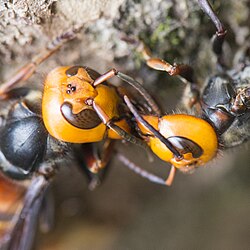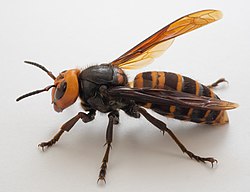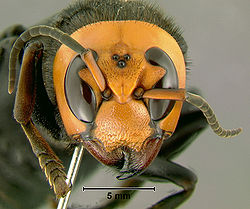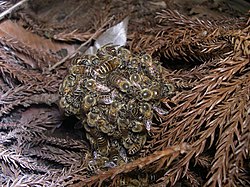20210216-ARS-LSC-0471 (51021749747)
From left, Vespa mandarinia, Asian giant hornet (AGH) larve and pupa in specimen tubes at the U.S. Department of Agriculture (USDA) Agricultural Research Service (ARS) Systematic Entomology Laboratory (SEL) where Research Entomologist Matthew L. Buffington works closely with the Smithsonian Institution National Museum of Natural History to identify captured hornet specimens and pass that information to other ARS scientists who are on the hunt for the infamous Asian giant hornet (AGH) — a threat to honey bees native to the United States, on February 16, 2021, in Washington, D.C.
When fully grown, the AGH is roughly 2 inches in length. This invasive species from Southeast Asia is the world’s largest hornet. It has distinctive markings: a large orange or yellow head and black-and-orange stripes across its body. ARS is investigating the AGH, dubbed the “Murder Hornet” because when they enter honey bee colonies to harvest bees for food for their own colonies, they bite the bees’ head off. Asian bees have learned how to kill the AGH by covering it to use their bodies to overheat and kill it. Bees in North America do not know how to do this. The AGH are more dangerous to insects than anything else. While the hornet’s sting delivers a potent venom, it poses a health concern for people with bee or wasp allergies, but attacks against humans are rare. A few AGH specimens were discovered last year in the Pacific Northwest. ARS postdoctoral research associate Jacqueline Serrano leads the team efforts to develop attractants for use as bait in AGH traps in Washington State. RFID (radio) devices have been used to track hornets back their nest. In the Pacific Northwest, honey bees play a significant role in the production of many fruit crops including apples, berries, pears, and cherries. “If AGH were to become established in Washington State, it could pose a serious threat to the beekeeping industry,” Serrano said. “AGH could subsequently impact the state’s billion-dollar agriculture industry.” ARS scientists will use those specimens to conduct genomic sequencing as part of the ARS Ag100Pest initiative. This initiative focuses on deciphering the genomes of 100 insect species that are most destructive to crops and livestock and are projected to have serious bioeconomic impacts to agriculture and the environment.
USDA Photo by Lance Cheung.Flinfo has extracted the license below from the metadata of the image (tag "IFD0:ImageDescription" contained "USDA Photo"). The license visible at Flickr was "Public Domain Mark".
Relevantní obrázky
Relevantní články
Sršeň mandarínskáSršeň mandarínská je druh jedovatého sociálního blanokřídlého hmyzu z čeledi sršňovitých a rodu Vespa (sršeň). Žije v jižní, jihovýchodní a hlavně ve východní Asii, jako invazní druh se roku 2019 objevil i v Kanadě a v USA. Pro svůj biotop preferuje lesy ve středních nadmořských výškách. Jedná se o největší známý druh sršně; dělnice dosahují délky minimálně 3 cm a královny mohou měřit až okolo 5,5 cm a mít rozpětí křídel i více než 7,6 cm. Hlava je relativně masivní a celá tmavě žlutá až oranžová. Žihadlo měří 6 mm a disponuje velkým množstvím poměrně silného jedu. .. pokračovat ve čtení














